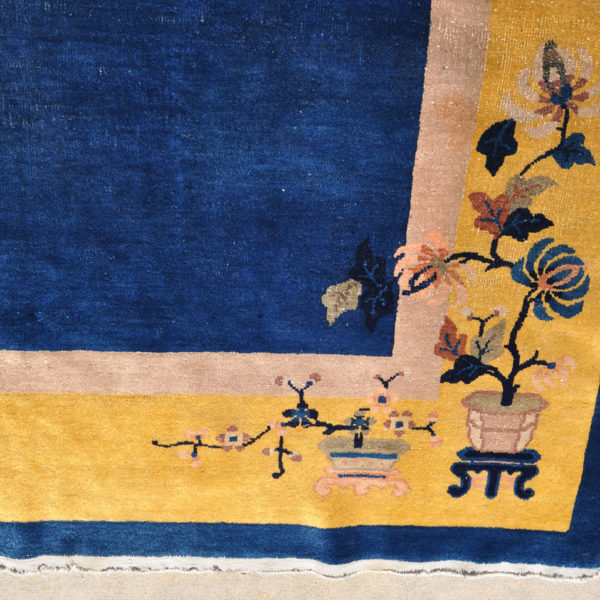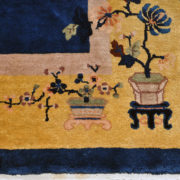Description
Lustrous indigo blue and gold antique Chinese rug.
These are sometimes labeled as Peking carpets but more commonly referred to as Nichols or Fette era Art Deco rugs.
The rug displays an elegant, serene and balanced combination of plants, vines, flowers, and vases.
This large 1930s – 1940s Chinese rug has moderate areas of wear on the wool pile. The side cords and fringes are in excellent condition. I’ve provided a number of closeup photos to show the pile wear.
No holes, weak spots, or odors.
Natural wool on cotton warp. Exact size is 12 ft. by 8 ft. 10 in.
Despite the age and moderate wear, the rug remains very solid and can be used anywhere on the floor.
Nichols’ carpets and their kin are well known for their resilience to wear, tear, and the vicissitudes of time.
The term Art Deco refers to the style launched at the 1925 Paris World’s Fair Exhibition of Modern and Industrial Decorative Art.
Art Deco rugs introduced a broader color palette into Chinese rugs. A more open field with less cluttered elements became popular.
Because of its low production costs, China became the hub for weaving Art Deco rugs exported to the United States. There were hundreds of factories producing rugs but it was two enterprising Americans who dominated: Helen Fette and Walter Nichols. Little did they know their names would become synonymous with the term and virtually all rugs woven during that era, which ran mainly from the mid 1920s to late 1930s.
In 1924 Walter Nichols opened the doors of his venture, Nichols Super Yarn and Carpets in Tientsin, North China. Super Yarn because of the machine spun yarn, the strong cotton used for the foundation, and the overall tightly packed weave of the rugs.
Because Fette and Nichols were so closely associated with the Deco period, rugs woven in their trademark style, absent any identification marks, are routinely referred to as Fette or Nichols carpets.
No other Oriental rugs are as representative of their time as the Chinese Decos. The dynamics of the designs and the colors used are hallmarks of the era. It was a time of experimentation with abstract forms and unrestrained colors.
The style arrived energetically but was drastically reduced due to the Great Depression. The few remaining factories not closed from Depression era economic woes, were shuttered when Japan invaded China during World War II.
Walter Nichols is the best known manufacturer of these Chinese rugs, but other companies were weaving very similar high quality rugs for the American home in the 1920s and 1930s. They are highly collectible today and noted for their ironclad durability. (One jaundiced rug ‘expert’ who disliked these carpets lamented that they are impossible to escape because of their virtual indestructibility.)
“The Nichols name has come to be used almost synonymously with the ‘Chinese deco’ rugs manufactured in Tientsin in the 1920s and 1930s. Nichols did not originate the Chinese deco style, but he did a great deal to popularize it and to maintain its high standards of manufacture.”
After the Japanese invasion and occupation of China in 1937, the growing inferno of the Second World War, and finally the Communist Revolution in mainland China in 1949, the era of the Nichols’ rugs ended. However, they continued to exert an influence on rug production in the People’s Republic of China.
Shipping with the U.S. is $69.
Please email me with questions. Thank you.
(C0028 O83)








